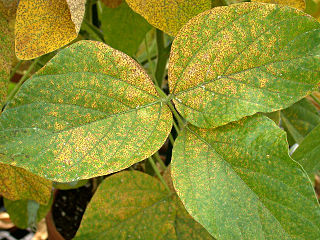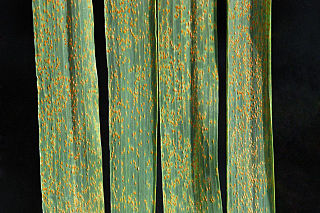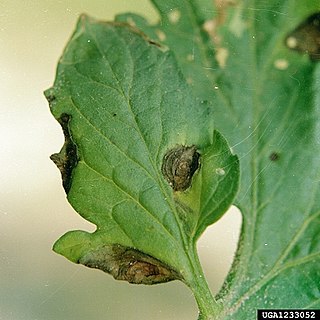
Rusts are fungal plant pathogens of the order Pucciniales causing plant fungal diseases.

Soybean rust is a disease that affects soybeans and other legumes. It is caused by two types of fungi, Phakopsora pachyrhizi, commonly known as Asian soybean rust, and Phakopsora meibomiae, commonly known as New World soybean rust. P. meibomiae is the weaker pathogen of the two and generally does not cause widespread problems. The disease has been reported across Asia, Australia, Africa, South America and the United States.

Wheat leaf rust is a fungal disease that affects wheat, barley, rye stems, leaves and grains. In temperate zones it is destructive on winter wheat because the pathogen overwinters. Infections can lead up to 20% yield loss. The pathogen is a Puccinia rust fungus. It is the most prevalent of all the wheat rust diseases, occurring in most wheat-growing regions. It causes serious epidemics in North America, Mexico and South America and is a devastating seasonal disease in India. P. triticina is heteroecious, requiring two distinct hosts.
Barley stripe rust is a fungal disease of barley caused by Puccinia striiformis f. sp. hordei. a forma specialis of Puccinia striiformis. It was first detected in the United States in 1991, in northern and eastern Idaho in 1993, In 1995 it was detected for the first time in western Washington and western Oregon and is currently considered to be well established there. The disease initially develops at a small loci within a field and spreads rapidly and has caused significant losses in areas where climatic conditions are cool and wet.
Puccinia schedonnardii is a basidiomycete fungus that affects cotton. More commonly known as a “rust,” this pathogen typically affects cotton leaves, which can decrease the quality of the boll at time of harvest. As large percentages of cotton in the United States are resistant to various rust varieties, there is little economic importance to this disease. In places where rust is prevalent, however, growers could see up to a 50% reduction in yield due to rust infection.

Albugo is a genus of plant-parasitic oomycetes. Those are not true fungi (Eumycota), although many discussions of this organism still treat it as a fungus. The taxonomy of this genus is incomplete, but several species are plant pathogens. Albugo is one of three genera currently described in the family Albuginaceae, the taxonomy of many species is still in flux.

Alternaria solani is a fungal pathogen that produces a disease in tomato and potato plants called early blight. The pathogen produces distinctive "bullseye" patterned leaf spots and can also cause stem lesions and fruit rot on tomato and tuber blight on potato. Despite the name "early," foliar symptoms usually occur on older leaves. If uncontrolled, early blight can cause significant yield reductions. Primary methods of controlling this disease include preventing long periods of wetness on leaf surfaces and applying fungicides. Early blight can also be caused by Alternaria tomatophila, which is more virulent on stems and leaves of tomato plants than Alternaria solani.

Puccinia asparagi is the causative agent of asparagus rust. It is an autoecious fungus, meaning that all stages of its life cycle – pycniospores, aeciospores, and teliospores – all develop upon the same host plant . Rust diseases are among the most destructive plant diseases, known to cause famine following destruction of grains, vegetables, and legumes. Asparagus rust occurs wherever the plant is grown and attacks asparagus plants during and after the cutting season. Asparagus spears are usually harvested before extensive rust symptoms appear. Symptoms are first noticeable on the growing shoots in early summer as light green, oval lesions, followed by tan blister spots and black, protruding blisters later in the season. The lesions are symptoms of Puccinia asparagi during early spring, mid-summer and later summer to fall, respectively. Severe rust infections stunt or kill young asparagus shoots, causing foliage to fall prematurely, and reduce the ability of the plant to store food reserves. The Puccinia asparagi fungus accomplishes this by rust lowering the amounts of root storage metabolites. The infected plant has reduced plant vigor and yield, often leading to death in severe cases. Most rust diseases have several stages, some of which may occur on different hosts; however, in asparagus rust all the life stages occur on asparagus. Because of this, many observers mistake the different stages of the Puccinia asparagi life cycle as the presence of different diseases. The effects of Puccinia asparagi are present worldwide wherever asparagus is being grown. Asparagus rust is a serious threat to the asparagus industry.

Puccinia helianthi is a macrocyclic and autoecious fungal plant pathogen that causes rust on sunflower. It is also known as "common rust" and "red rust" of sunflower.

Puccinia melanocephala is a fungus and plant pathogen, it is the causal agent of sugarcane rust. It was originally found on the leaves of a species of Arundinaria (cane) in Assam, India.

Puccinia menthae is a fungal plant pathogen that causes rust on mint plants. It was originally found on the leaves of Mentha aquatica.

Uromyces viciae-fabae var. viciae-fabae is a plant pathogen commonly known as faba-bean rust. The rust is distinguished by the typical rust-like marks on the stem and leaves, causing defoliation and loss of photosynthetic surface along with reduction in yield. The disease is fungal and is autoecious meaning it has one plant host. The rust of faba beans is macrocyclic, or contains 5 spores during its life cycle.
Puccinia pittieriana is a species of rust fungus. It is a plant pathogen which infects agricultural crops such as potato and tomato. Its common names include common potato rust and common potato and tomato rust.

Puccinia thaliae is the causal agent of canna rust, a fungal disease of Canna. Symptoms include yellow to tan spots on the plant's leaves and stems. Initial disease symptoms will result in scattered sori, eventually covering the entirety of the leaf with coalescing postulates. Both leaf surfaces, although more predominant on the underside (abaxial) of the leaf, will show yellow to brownish spore-producing these pustulate structures, and these are the signs of the disease. Spots on the upper leaf-surface coalesce and turn to brown-to-black as the disease progresses. Infection spots will become necrotic with time, with small holes developing in older leaves. These infected leaves eventually become dry and prematurely fall.

Puccinia monoica is a parasitic rust fungus of the genus Puccinia that inhibits flowering in its host plant and radically transforms host morphology in order to facilitate its own sexual reproduction.

Puccinia horiana is a species of fungus that causes chrysanthemum white rust, is a disease of plant species of the genus Chrysanthemum.
This article summarizes different crops, what common fungal problems they have, and how fungicide should be used in order to mitigate damage and crop loss. This page also covers how specific fungal infections affect crops present in the United States.

Puccinia poarum, a species of fungus, known as the coltsfoot gall rust, or meadow grass rust, is a plant pathogen. This fungal parasite forms a yellow to orange gall, 1–2 cm in diameter, on the underside of leaves of coltsfoot. It also infects but does not gall grasses of the family Poaceae. P. poarum is a genetically diverse species that has been reported on at least seventy plant hosts. It was originally found on Poa fertilis and Poa nemoralis in Denmark in 1877.
Phakopsora euvitis is a rust fungus that causes disease of grape leaves. This rust fungus has been seen in regions including: Eastern Asia, Southern Asia, Southwestern Brazil, the Americas, and northern Australia. It is widely distributed in eastern and southern Asia but was first discovered on grapevines in Darwin, Australia in 2001 and was identified as Asian grapevine leaf rust by July 2007.

Puccinia porri is a species of rust fungus that causes leek rust. It affects leek, garlic, onion, and chives, and usually appears as bright orange spots on infected plants.














